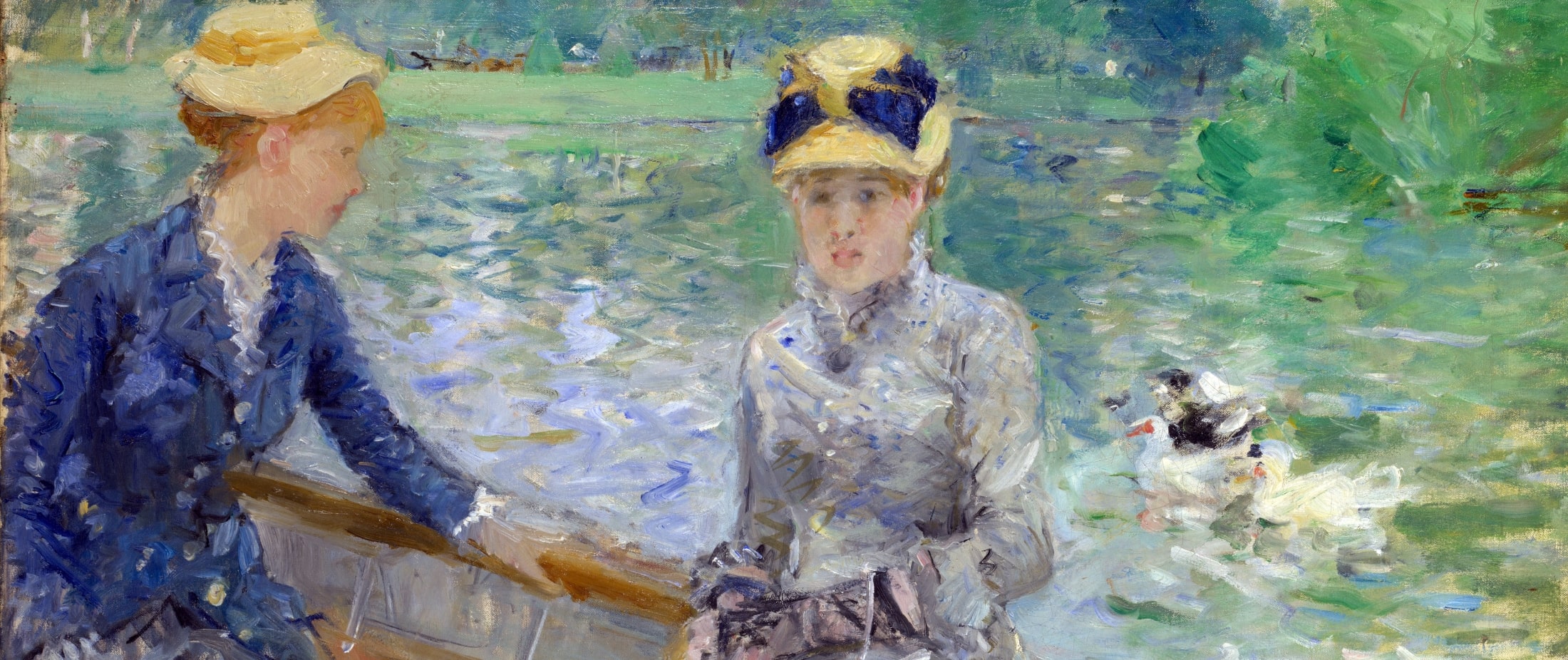
12 female artists challenging the status quo
For much of history, women have rarely been acknowledged in the art world and art museums today still only have a fraction of works created by women. According to a study carried out in 2017 by Artnet Analytics and Maastricht University in 2017, only 13.7% of living artists represented in galleries across Europe and North America are female.
In recent years, this imbalance has been in the spotlight. While today women are still dramatically underrepresented, art history is gradually being reshaped.
From Artemisia Gentileschi to Nancy Holt, here we look at 12 of the most famous female artists of all time in a world dominated by men and how they challenged the status quo and paved the way for future generations of women in the arts.
1. Artemisia Gentileschi (1593-1653)
An Italian Baroque Painter producing work since the age of around 15, Artemisia Gentileschi is considered to be one of the most accomplished 17th-century artists. She worked in Rome, Florence, Venice, Naples, and London, among the upper class of European society, including the Grand Duke of Tuscany and Philip IV of Spain. She was a “feminist” before the term was invented, in each of her pieces displaying her fight for gender equality and helping re-imagine the concept of womanhood, paving the way for many of today’s future feminist painters.
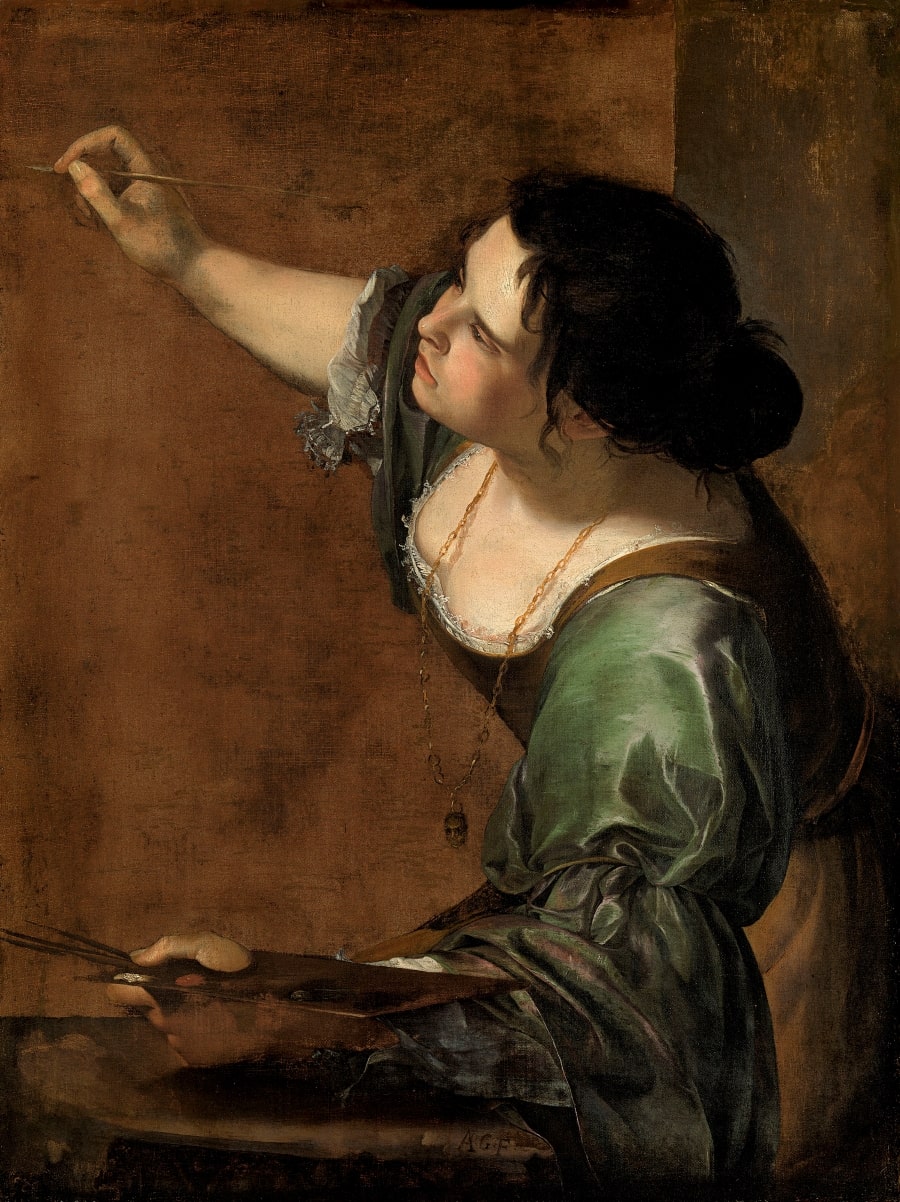 Self-Portrait as the Allegory of Painting (La Pittura), Artemisia Gentileschi, c. 1638-1639
Self-Portrait as the Allegory of Painting (La Pittura), Artemisia Gentileschi, c. 1638-1639Her painting ‘Danae’ (c.1612) was inspired by the Greek mythological character who was locked in her room by her father, King Acrisius of Argos, to stop her from getting pregnant. She was visited by Zeus, who appeared as a shower of gold, as rain, and impregnated her. Gentileschi put strong female figures at the centre of her work, which has perhaps helped to establish herself as an iconic female painter. This masterpiece can now be found in the collection of the Saint Louis Art Museum in the USA.
Another of her most iconic works, and one of the most iconic of the Baroque era, ‘Judith slaying Holofernes’, which she painted two times, further explores women’s strength. Both paintings depict two women, Judith and her loyal maid, beheading Holofernes, the general of the enemy camp. The overall effect of the explicit gory details is powerful and frightening. You can see the first of these two works, painted in 1611-1612, at the Museo Capodimonte, Naples, Italy and the latter (1620) at the Uffizi in Florence.
Today, Gentileschi’s paintings can be found across the globe, from the National Gallery in London to the Gallerie d'Italia in Naples.
2. Angelica Kauffman (1741-1807)
A Swiss Neoclassical painter who became well known mostly in London and Rome, Angelica Kauffman’s primary interests were historical paintings, but she also was known as a portrait, landscape, and decoration painter. Much like Gentileschi, Kauffman was a daughter of an artist, but her art was mostly influenced by the Neoclassicism movement and English romantic literature, which helped her to achieve her success in England. Along with Mary Moser, she was one of two female founding members of the Royal Academy of Arts in London in 1768.
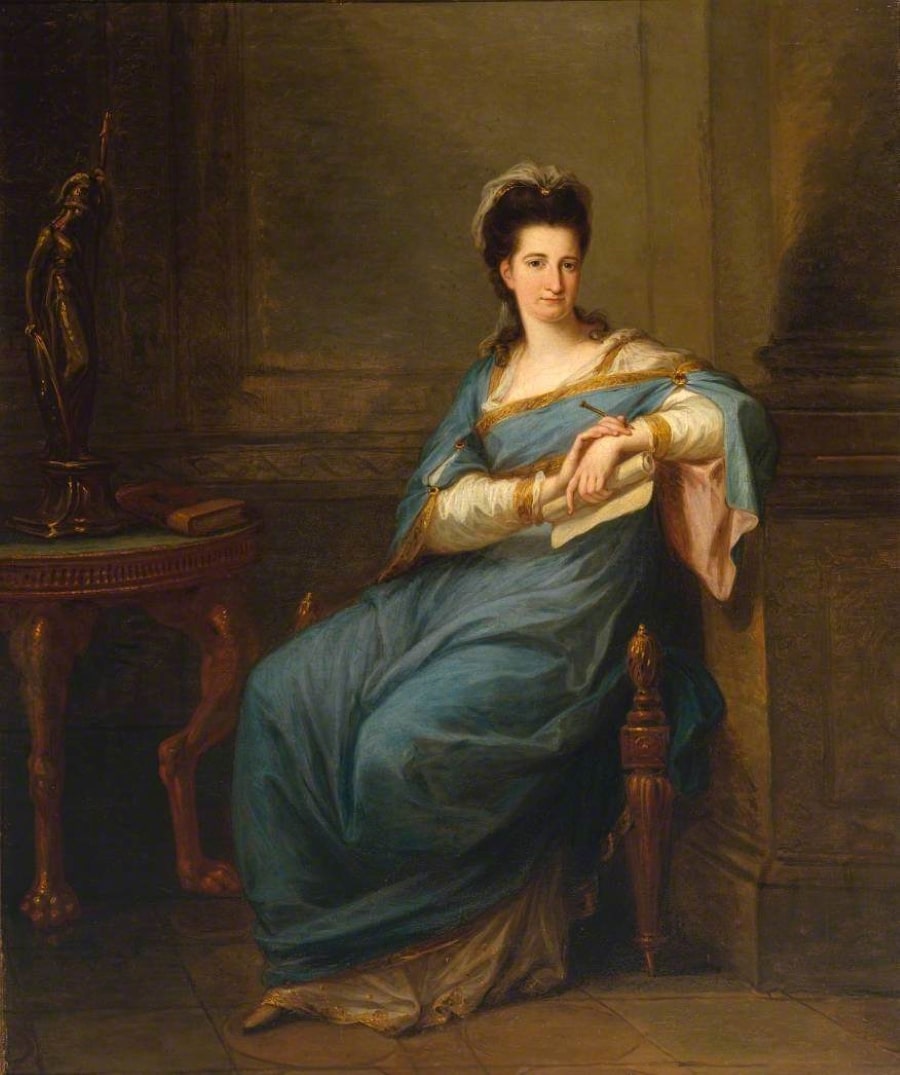 Portrait of a Lady, Angelica Kauffman, c. 1775 © Tate Britain, London
Portrait of a Lady, Angelica Kauffman, c. 1775 © Tate Britain, LondonHer most famous painting ‘Portrait of a Lady’ (c. 1775) depicts a woman in classical costume sitting with a scroll of parchment and pen and entered Tate’s collection in 1967. It was thought to be a self-portrait but who the sitter is has been debated since then. The small-scale painting addresses developments in women’s education towards the end of the 18th century, in a neoclassical style, fashionable in London at the time.
One of Kauffman’s renowned historical paintings was ‘Telemachus and the Nymphs of Calypso’ (1782) based on the story of Telemachus, son of Odysseus. The painting depicts the Greek myth of Telemachus’ arrival on Calypso’s Island, where he was welcomed by her nymphs. The goddess, Athena, disguised as an old man, is being led away to the left of the frame.
Some of the artist’s paintings can be found in the Angelika Kauffmann Museum in Schwarzenberg, in Austria, which was established in 2007.
3. Rosa Bonheur (1822–1899)
A French realist painter and sculptor best known for her animal paintings, Rosa Bonheur was the first woman artist to be named a Knight of the Legion of Honour.
She was a daughter of the painter Oscar-Raymond Bonheur, who encouraged all his children to become artists. He admitted Rosa to his studio and trained her. It was in her father's studio that she showed her artistic skills and interest in animals. Later she took inspiration from reality by owning her own menagerie, frequenting slaughterhouses, and dissecting animals for first-hand anatomical information.
 The Horse Fair, Rosa Bonheur, c. 1852-1855 © Metropolitan Museum of Art
The Horse Fair, Rosa Bonheur, c. 1852-1855 © Metropolitan Museum of ArtHer work ‘The Horse Fair’ (1852-1855) depicts a scene of a horse sale. Despite the fact that women were not permitted to attend, Bonheur disguised herself as a man so that she could sketch horses at the fair without being detected. When asked about her inspiration for the piece, Bonheur said that ‘The Horse Fair’ was her take on the ‘Parthenon frieze’: the engravings on the ceiling of the ancient marble Parthenon which depict the battle between the Centaurs and Lapiths at the marriage feast of Peirithoos.
Her painting ‘Sheep by the Sea’ (1855) was inspired by a trip through the Scottish Highlands in the summer, and shows a flock of sheep settled in a meadow near the sea. Like most of her pieces, ‘Sheep by the Sea’ illustrates the artist’s commitment to depicting realism from nature.
Her work was exhibited in Musée d’Orsay in 2022 to mark the bicentenary of her birth in Bordeaux, providing an overview of the many aspects of Bonheur's work.
4. Berthe Morisot (1841-1895)
French artist Berthe Morisot was a trailblazer in the impressionist movement in the 19th century. Her paintings are made up of loose brush strokes often depicting the bourgeois at home or in the garden with a particular interest in the importance of fashion and women’s domestic work. Her technique involved making use of plein air painting much like other painters in the impressionist group at the time like Claude Monet and Camille Pissarro.
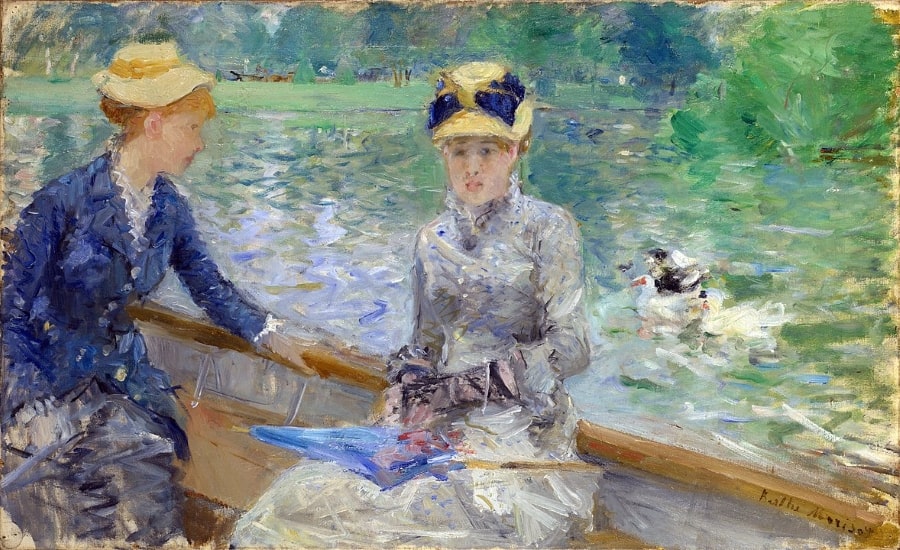 Summer’s Day, Berthe Morisot, c. 1879
Summer’s Day, Berthe Morisot, c. 1879‘Summer’s Day’ (1879) was inspired by the Bois de Boulogne in Paris, close to her house and studio. Two upper-class women are illustrated to be seated in a rowing boat in a shimmering lake created by dabs of blue and green brushstrokes. Morisot scarcely painted male figures, focusing on the importance of female characters in her pieces instead.
‘Woman at her toilette’ (1875–1880) is consistent with the impressionist style of Morisot. By using feathery brushstrokes in soft shades of lavender, pink, blue, white, and grey, Morisot moves into the realm of female eroticism that was hardly approached at this time by female artists.
The Musée Marmottan Monet in Paris holds the largest collection of Morisot’s pieces with 25 oil paintings, 75 watercolours and numerous pastels and drawings.
5. Clementine Hunter (1886 – 1988)
Clementine Hunter was an African American folk artist from Louisiana. She never learned to read or write but became known for her artworks representing her life on a plantation where she lived and worked.
She began by painting on plates and bits of discarded fabric in her 50s and received an honorary fine arts degree from the Northwestern State University of Louisiana in recognition of her achievements in 1986. By the end of her life her works were exhibited in renowned museums, such as the Dallas Museum of Art, the American Folk Art Museum, Minneapolis Institute of Arts, the Ogden Museum of Southern Art, the New Orleans Museum of Art, and the Louisiana State Museum, and sold to collectors including Oprah Winfrey. She is one of the most celebrated Black women painters in history.
 The Wash, Clementine Hunter, 1950s © Minneapolis Institute of Art
The Wash, Clementine Hunter, 1950s © Minneapolis Institute of ArtHer colourful works of art make use of flat planes of colour and scale shifts and depicted everyday scenes from her own daily life. One of her most acclaimed works was ‘The Wash’ (1950s), in which three women are depicted to be doing everyday tasks. She was renowned for her vibrant palette and expressive style, and her purposeful disregard for perspective and scale. Other works Hunter created include ‘Funeral Procession’ (1950), ‘Melrose Quilt’ (1960) and ‘Zinnias in a pot (1965).
6. Natalia Goncharova (1881-1962)
A Russian avant-garde artist, painter, costume designer, writer, illustrator, and set designer, Natalia Goncharova was well known in Moscow for her scenery and costume designs for the Kamerny Theatre. She found fame early in her career, at age 32, in a major exhibition in Moscow in 1913, establishing herself as one of the leaders of the Avant-Garde movement. She then became an integral part of the cutting-edge art scene in Paris after she played a part in designing costumes and backdrops for Sergei Diaghilev’s ‘Ballet Russes’. Her Byzantine-inspired designs for the ballet ‘Coq d'Or’ (1914) were also outstanding.
Goncharova’s bold and innovative work, including body art and religious paintings, influenced many of the art movements of the 20th century. Her pieces are said to be inspired by many sources of inspiration including Russian folk art and textiles, alongside the latest trends in modernism. She did not allow the traditions of the Russian Empire to stand in her way, she was even tried for obscenity due to her paintings of nudes that were considered to be scandalous.
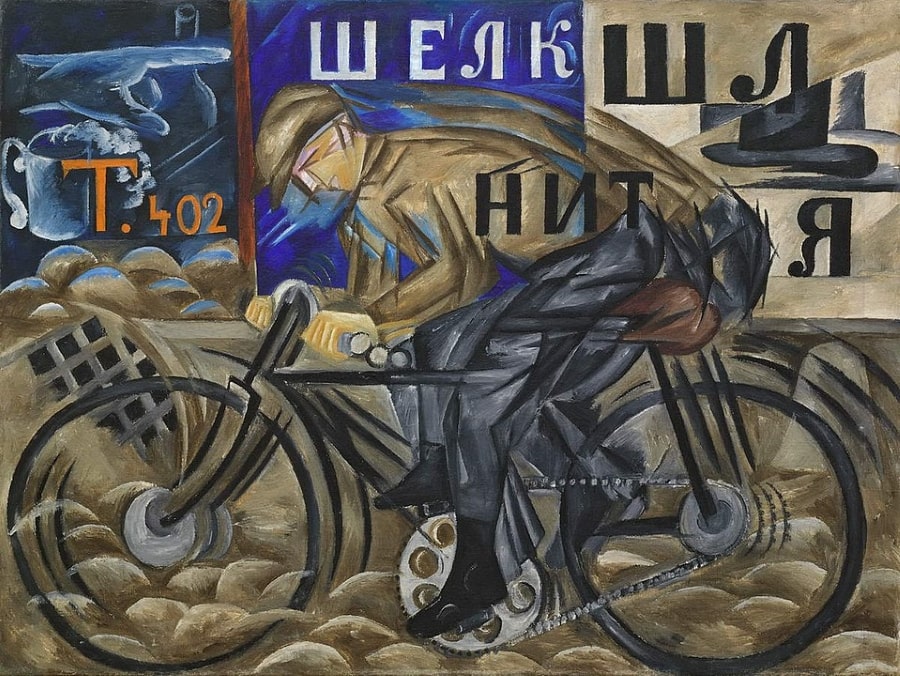 Cyclist, Natalia Goncharova, c. 1913
Cyclist, Natalia Goncharova, c. 1913Her most famous painting, ‘Cyclist’ (1913), is a Cubo-Futurist painting in which the bicycle, the figure, and the background seem to fuse together in a single form. The shapes merge together to represent the dynamic feeling of the cyclist moving through time and space rather than a static figure which reflects the overwhelming turbulence of the city.
This dynamic feeling is greatly juxtaposed with the sense of tranquillity presented in her more rural-inspired paintings, for example, ‘Linen’ (1908) presents three peasant women, drying their laundry barefoot. Goncharova reflects on the effects of Russia’s evolution at the time showing how the cities progressed, while life in rural areas remained the same.
7. Kathe Kollwitz (1867-1945)
It is my duty to voice the sufferings of men, the never-ending sufferings heaped mountain high. This is my task, but it is not an easy one to fulfil,
Kathe Kollwitz, referred to by Tate as
one of the great graphic artists and printmakers of German expressionism,
once said.
Kollwitz’s work centres mainly around women and the working class, subjects that established her as an original female artist in the art world that was, at the time, dominated by men. Her work has earned her international acclaim, involving the use of many mediums to show compassion for those who are impoverished, suffering or in need.
Her most famous series of works include ‘A Weavers’ Revolt’ (1893-97) and ‘The Peasant War’ (1901-08). She created ‘A Weavers’ Revolt’ after seeing Gerhart Hauptmann’s play ‘The Weavers’ (1892), which told the story of the 1844 uprising of Silesian weavers. The audience, at the time, was deeply moved, driving the success of the artist. ‘The Peasant War’ is a series of etchings focusing on the rural population in pre-revolutionary Germany which acted as a crucial starting point for the fight for freedom in the revolution and is on display in Käthe Kollwitz Museum Köln in Cologne, Germany.
Personal traumatic experiences, such as the loss of her son during World War One, lead to her interest in the exploration of mourning and pain. ‘War’ (1921-22) is a series of woodcuts. The most prominent work from this series of seven woodcuts is ‘The Widow II’ (1922) in which she depicts the limp bodies of a mother and child. Critics have speculated that these types of prints were produced as a memorial of the death and loss caused by World War I. The stark light and dark contrasts created through the woodcuts depict the emotion and depth of each piece, spotlighting the main focus of the etching, the two lifeless figures in the centre.
The Kathe Kollwitz Museum in Cologne is the home to many of her pieces, with over 300 drawings and over 550 of her prints.
8. Barbara Hepworth (1903-1975)
Barbara Hepworth was an English Modernist artist, mostly known for her sculptural work. She has been referred to as a main inspiration to many contemporary figures, including Tracey Emin and Charlotte Moth. Hepworth tragically died in a fire in her studio caused by a cigarette setting alight to her bedclothes.
One of her most significant later works is called ‘Squares with two circles’ (1956), which is one of her largest pieces, and is created entirely out of metal. Like many of her sculptures, it is created to be situated outside to incorporate its geometric form with nature, the form of the sculpture shifts and changes due to the time of day and direction of light, giving a sense of the piece expanding and breathing.
She has been known to produce a variety of sculptures referring to the mother and daughter relationship, this is reflective of the dual roles she often did alongside each other as sculptor and mother. ‘Mother and child’ (1934) is made out of a single piece of clay but with two separate elements consisting of an abstract depiction of a reclined mother resting her child on her thighs. The fact that the two elements are melded together creates a sense that the mother and child are of the same entity, referring to the closeness of motherhood, the effect is one of a completely undeniable connection.
Hepworth’s work can be found across the world, including at the Tate Gallery in London, the Museum of Modern Art in New York, and the Lehmbruck-Museum in Germany.
9. Olga Rozanova (1886-1918)
Rozanova was a Russian avant-garde artist who painted in the styles of Suprematism, Neo-Primitivism, and Cubo-Futurism, making her one of the few women in this artistic field. Her interpretations of spiritual energy and colour interaction result in dynamic and unique artwork. She tragically died in 1918 from diphtheria, and if she hadn’t it is arguable that she would be placed alongside Kazimir Malevich as a pioneer of 20th-century abstract painting.
 Green Stripe, Olga Rozanova, c. 1917
Green Stripe, Olga Rozanova, c. 1917One of her most famous pieces is ‘Green Stripe’ (1917) which is seen as a precursor of post-World War II Abstract Expressionism. Another of her most famous works is ‘Color Painting (Non-Objective Composition)’ (1917). The piece features clean, sharp edges in a composition of geometric shapes to create a severe arrangement. Her non-objective approach means that her paintings do not bear reference to a specific object or scene, but rather permits the viewer to interpret the piece as they desire.
The theme of geometric surrealism carries throughout her pieces, including ‘Flight of an Aeroplane’ (1916), ‘Suprematism’ (1916), and ‘Universal War’ (1916).
Rozanova’s work is currently on display at the Kroller-Muller Museum in the Netherlands until September 3, 2023. In the past, a number of well-known galleries and museums such as The State Russian Museum have exhibited Olga Rozanova's work.
10. Louise Bourgeois (1911-2010)
I transform nasty work into good work. I transform hate into love,
Bourgeois, the French-American painter and printmaker best known for her large-scale sculpture and installation art, once said.
Her art career spanned almost eight decades, making her one of the most recognizable figures in the modern and contemporary art world. She would transfer her own aggression and frustration from her personal life into her pieces. Take for example, ‘Janis Fleuri’ (1968), in which two opposing faces are suspended in the air. The work refers to the Roman god Janus, who has one male head and one female head, with one looking to the past and the other to the future.
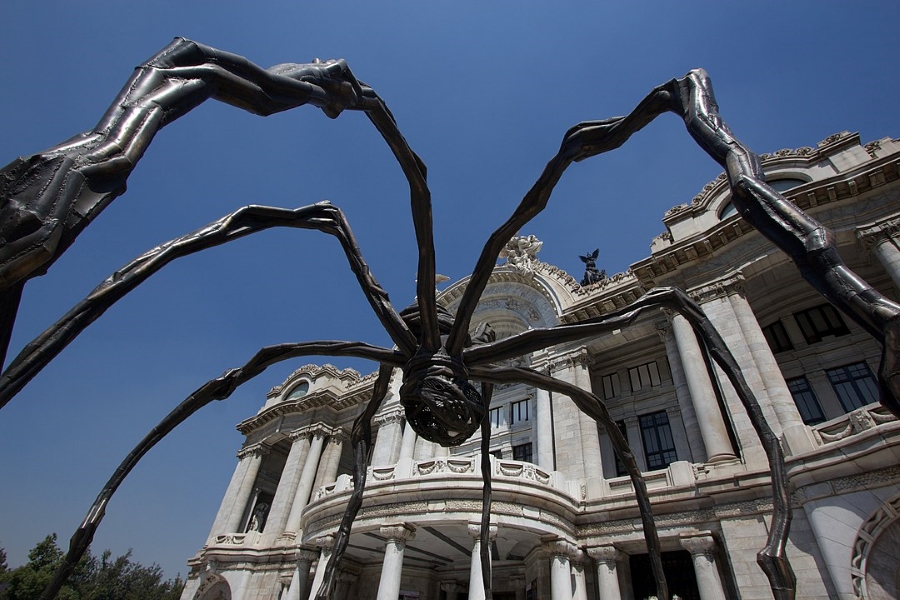 Maman, Louise Bourgeois- Palacio de Bellas Artes, Mexico City, Mexico © Eduardo López Urrutia
Maman, Louise Bourgeois- Palacio de Bellas Artes, Mexico City, Mexico © Eduardo López UrrutiaHer works ‘Spider’ (1996) and ‘Maman’ (2002) are only a few of her sculptural pieces centred around the arachnid figure. Bourgeois has claimed to identify the spider figure with her mother as a weaver and a protector, however, it is hard to ignore the fear that the benevolent figure of a spider instils in the viewer. She presents this juxtaposition between strong and weak, safe and dangerous. Furthermore, the metaphor of the spider as a creator bears a connection to her own artistic process. A film was made about her life, aptly named ‘Louise Bourgeois: The Spider, The Mistress and The Tangerine’ (2008).
There seems to be a shift in her work throughout her artistic career. In her early work, it is evident that she is harbouring anger towards her father and his mistress which she first experienced in her traumatic childhood. As the artist matures, her late work shows more of an identification with her mother, who died when she was just 22. Pieces that involve tapestry and sewing work reflect a connection that Bourgeois is trying to make with her lost maternal figure. It is without doubt that all of her pieces reflect her profound human emotions and her philosophy towards how she views life: trying, failing, and trying again.
11. Joan Mitchell (1925-1992)
An American artist who worked primarily in painting, printmaking, and pastels, Joan Mitchell’s primary medium was oil paint on canva and she established herself in the abstract art world in New York. She was an active participant in the New York School of Artists in the 1950s and is widely recognised as one of the most influential artists in the post-war era, a time when few female artists were recognised.
The Joan Mitchell Foundation was founded in 1993, following the death of Mitchell in 1992. It maintains the appreciation of Mitchell’s life and work while fulfilling her wish to “aid and assist” working artists in order to continue her legacy. Through its work, the Foundation, both, asserts and reinforces artists’ essential contributions to society.
Her paintings are inspired by poetry, landscape, and nature, they portray emotion and feeling rather than tangible muses. For example, ‘City Landscape’ (1955) is inspired by urban energy. She created tension between the stark white and grey colours and contrast with her abrupt brushstrokes. The piece blurs the lines between abstract and impressionist art, like most of her artwork, she even referred to herself as the ‘last Abstract Expressionist’. ‘Bracket’ (1989), one of her largest pieces, is 15 feet wide, and she used three panels to make up the composition, much like stanzas in a poem.
In 2022, Fondation Louis Vuitton in Paris created a retrospective exhibition that exhibited both Mitchell and Monet creating an unprecedented dialogue between the two exploring how they both regard nature and landscape in their own unique ways.
12. Nancy Holt (1938-2014)
Holt was an American artist famous for her public sculpture, installation art, concrete poetry, and land art. Along with her husband, Robert Smithson (1938-1973), she was a founder of the Land art movement in the 1970s. She has also published many books about art and worked in various other media including film and photography. She often worked with Smithson, an extremely influential artist and theorist, however, it meant that her own work remained in the shadow of her husband’s.
She was an innovator for site-specific sculptures and the focus on the moving image, which was said to reshape the development of art, embracing the media in the world of modern technology.
She also created an installation called ‘Sun Tunnels’ (1977), in Utah’s Great Basin Desert, consisting of large 18 feet concrete tunnels, all perforated to imitate star constellations in the sky which are affected by the time of day. She consulted astrophysicists, engineers, and landscape architects during her creation of the work. Humans can sit inside these cylinders and observe the panoramic horizons in a reduced frame to reduce the overwhelming effect.
A smaller room-sized installation, ‘Holes of Light’ (1973), also plays with the reflection of light, the projections of light are outlined on the walls so that the circular cutouts in the bisected room are alluded to, even though they cannot be seen. This creates a dynamic experience of the relationships between the practical and perceived.
As an Art de Vivre subscriber, don’t miss our recent article on the most famous male artists of all time.
Credits for the Main photo: Summer’s Day, Berthe Morisot, c. 1879
Photo Credits: Wikipedia Commons
